- Home
- insider picks
- news
- The 3 best knife sets of 2023, tested and reviewed
The 3 best knife sets of 2023, tested and reviewed

When you buy through our links, Insider may earn an affiliate commission. Learn more
Purchasing one of the best knife sets is a quick and easy way to furnish your kitchen with cutlery, but know that you don't need very many blades, and you'll do more than fine with a chef's knife, a paring knife, and a bread knife. Beyond those, you might consider a Santoku for finely slicing meat, or a boning or utility knife for similarly precise work. (I'll add here that one of the best knife sharpeners is paramount.)
To test kitchen knives, we put them through their paces out of their packaging, then thoroughly dulled, resharpened, and retested them. Read more about how we tested, and if you're still unsure as to whether a pre-assembled knife kit will suit your needs, check out the pros and cons of buying your knives piecemeal.
Learn about how Insider Reviews tests and researches kitchen products.
Our top picks for the best knife setsBest overall: Wusthof Classic Ikon 7-Piece — See at Amazon
Wusthof's Classic Ikon 7-Piece Knife Block Set includes four well-balanced, durable, easy-to-grip knives, as well as a honing steel, kitchen shears, and a solid walnut block.
Best cheap set: Victorinox Swiss Classic Kitchen Set (5 piece) — See at Amazon
The knives in Victorinox's five-piece Swiss Classic knife set are lightweight, sharp out of the package, and easy to hold.
Best for small kitchens: F.N. Sharp — See at F.N. Sharp
F.N. Sharp knives feature 67-layer Japanese Damascus steel and riveted epoxy and fiberglass handles, which we find fit most hands best.
Best overall: Wusthof Classic Ikon 7-Piece
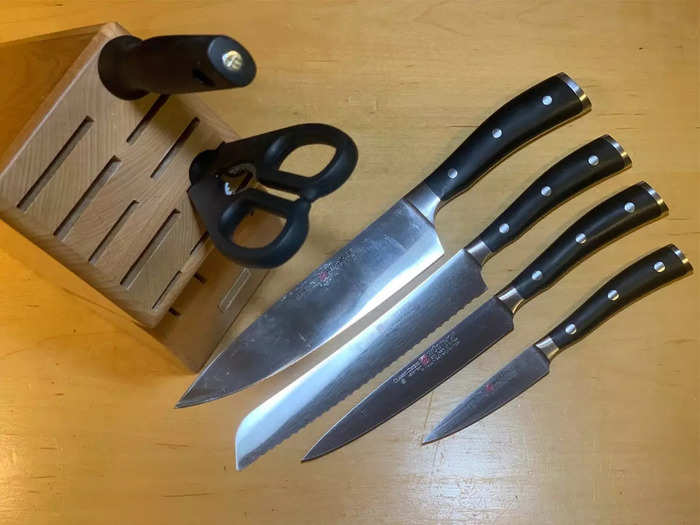
- Knives included: 3-1/2 paring knife, 6-inch utility (or boning) knife, 8-inch bread knife, 8-inch chef's knife, 9-inch honing steel, pair of "come-apart" kitchen shears
- Block included: Yes
- Materials: Proprietary high-carbon steel blades, POM (polyoxymethylene) handles
- Warranty: Limited lifetime against manufacturer defects
Pros: Great weight and balance, impressive edge retention, one of the best knife sets with a block
Cons: Small bread knife
If you're looking for a relatively affordable block set, Wusthof's Classic Ikon is the best you're going to do. Good knives are expensive, and so is a block of solid wood. Again, as we've stated above, you really, really don't need a big knife set like this (much less a knife block), but we can appreciate your wanting one, and we can't recommend this one enough.
The set includes our favorite eight-inch chef's knife for most people, plus a six-inch utility (or boning) knife, an eight-inch bread knife (perhaps a little short, but you'll make do), a nine-inch honing steel, and a 15-slot solid wood block.
These knives are head and shoulders above the ubiquitous X50CrMoV15 blades that make up most of what's available from budget-friendly DTC brands you'll come across. And while the X50CrMoV15 is perfectly serviceable, there's something that makes these blades much heavier (therein balanced) and more retentive of their edges. Sadly, Wusthof guards their proprietary alloy and we can't quite figure out what's in them.
Wusthof has been around for a long while, and is heavily endorsed by scores of renowned chefs with good reason. If you've got the funds and want a trusty knife set that does it all, this is it.
The Kilne The Knife Set knives bear a striking resemblance to our top pick, especially in the eastern-western hybrid handles, though they're made with the much more affordable X50CrMoV15 steel found in other popular and budget-friendly DTC knives. If you want an affordable block set, this seven-piece set is a great option.
Best cheap set: Victorinox Swiss Classic Kitchen Set (5 piece)
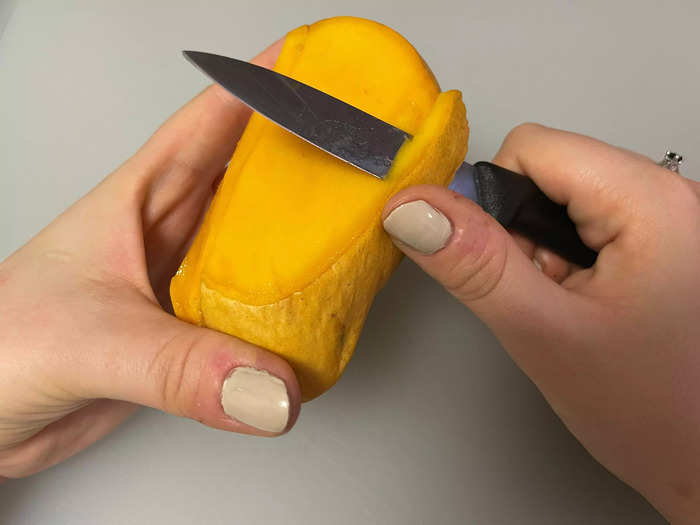
- Knives included: 3-inch serrated paring knife, 3-inch pointed tip paring knife, 4.3-inch tomato and table knife, 7.5-inch carving knife, 8.3-inch serrated bread knife
- Block included: No
- Materials: Stainless steel blades, polypropylene handles (PP), Victorinox's proprietary thermoplastic elastomers (TPE)
Pros: Ergonomic handles, sharp out of the package, lightweight, one of the best knife sets for the new homeowner in your life
Cons: Not as durable as high-carbon steel, plasticky feeling handles
Victorinox's five-piece Swiss Classic knife set comes with a 3.1-inch wavy edge paring knife, a 3.1-inch pointed tip paring knife, a 4.3-inch tomato and table knife, a 7.5-inch carving knife, and an 8.3-inch bread knife. It is actually cheaper than the Fibrox Pro set that we previously had the opportunity to review, and it comes with two bonus knives.
The drawback of the Classic knife set is that the blades are stainless steel instead of high-carbon steel. This is a lower-quality blade than the other knives of this list. If you need an introductory knife set at a fair price point, this is definitely the way to go. If you are looking for a gift for the seasoned chef in your life, this is probably not the best pick.
While these knives are dishwasher-safe, handwashing is recommended to extend the longevity of your knives. The Victorinox Classic knives are extremely sharp out of the package, and since they do not come with a block, you should be careful when storing them. In our Victorinox Knife Set review, we noted that the knives felt light, and while the handles were ergonomic, the plasticky texture was a bit slippery to hold onto.
Both paring knives in this set cut fruits with ease, and the bread knife creates even slices without tearing. If you were looking for an even bigger set, Victorinox makes a 7-piece Swiss Classic Set that comes with similar pieces. The notable difference is that the 7-piece set comes with a carving fork, peeler, and santoku knife instead of an additional paring knife.
If you're on a really tight budget, we also like the Goldilocks Knife Set. Though the blades outweigh the handles, they held up in testing.
Read our full Victorinox Swiss Classic Knife Set review.
Best for small kitchens: F.N. Sharp
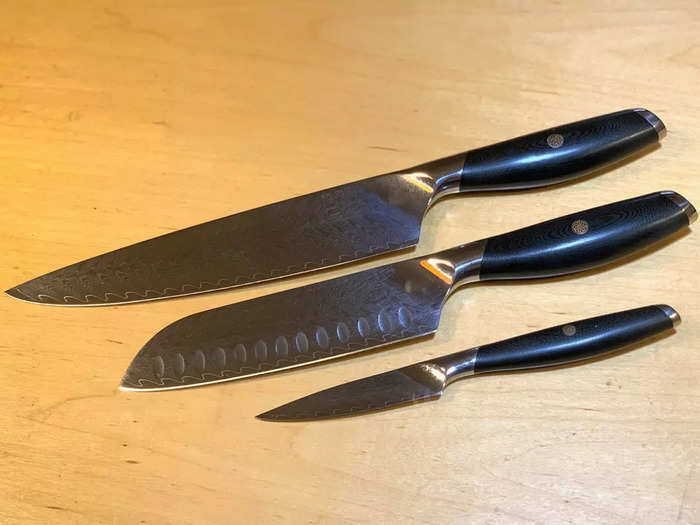
- Knives included: 3-1/2-inch paring knife, 6-inch Santoku, 8-inch chef's
- Block included: No (but available)
- Materials: 67-layer Damascus steel blades, riveted G10 fiberglass and epoxy handles
Pros: High-quality steel, great edge retention, exceptionally comfortable handles, one of the best knife sets for small kitchens
Cons: A little difficult to sharpen yourself (but that's what the sharpening service is for)
A three-and-a-half-inch paring knife, a six-inch Santoku (or Santoku Bocho, which translates to "three uses": chopping, mincing, and dicing), and an eight-inch chef's knife make up this elegant, if pared-down, kitchen knife set. If your needs would be better suited by a six-piece set, which also includes a bread knife, a boning knife, and a utility knife, that's also available for $660.
Apart from looking unbelievably cool thanks to the VG-10 steel patterned into the blade, these knives are the most balanced and solidly built of any we've tried. We also like that three "sharpenings" are included with the purchase of every set, which should get you through a year to a year-and-a-half of constant use.
We put "sharpenings" in quotations because what the brand actually does — and this is pretty ingenious, we must say — is send you a replacement set of freshly sharpened knives in a box with a prepaid packaging slip into which you'll put your used, dulled knives for return. After the first three sharpenings, though, the cost is on you and it's admittedly steep: $60 for the three-knife set, $90 for the six-knife set, and $50 for a steak knife set. For comparison, most local services will charge you $2-$3 per inch of blade.
For small spaces, we also like a Japanese set. Shun is a favorite of some of the world's top chefs, and the 2-Piece Sora Set is one of their more economical pairs. If you're interested in Japanese blades but don't want to break the bank, these are a great start.
Read our F.N. Sharp knives review.
What to look for when buying a knife set
Quality steel
Decent steel starts most commonly with X50CrMoV15, and is standard for the entry-level to mid-level market. Beyond that, there tend to be a lot of proprietary alloys, but you can also look for 440B or C (A has great qualities, but not generally for a kitchen knife), and VG8 or VG10.
What are the most important knives?
A chef's knife is far and away the most important knife. Period. Some will call for a butcher's knife or a Santoku, but there's a common thread with each of these, and that is that they're all large-bladed knives capable of handling most jobs.
A bread knife is another staple for obvious reasons (if you eat bread).
A paring knife might follow. It's great for smaller tasks like hulling fruits and chopping smaller things like garlic, chives, and other herbs.
A utility, carving, or boning knife, which is relatively long (six inches, give or take) and thin is handy for carving and finer slicing of meat and fish.
An alternative would be a meat cleaver, which can be great as an all-around knife too. But there are all sorts of other knives that might earn a spot in your kitchen depending on what you do most, but these are the basics.
How we tested each knife set
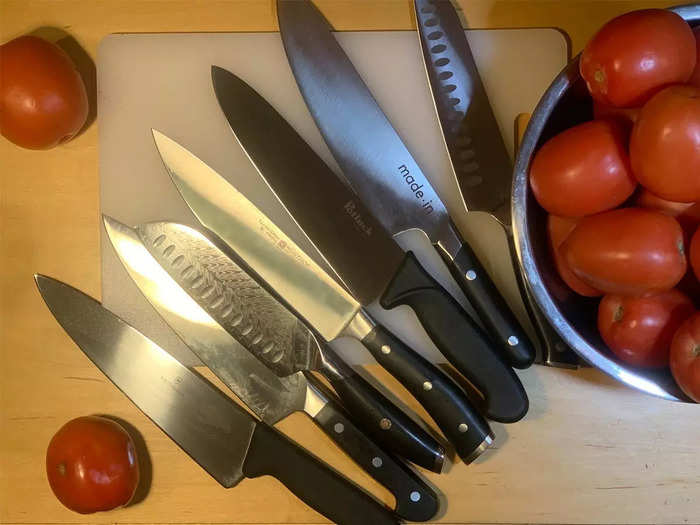
I've been using knives regularly — as most of us have — for the better part of my life, and on and off professionally. I relied on my own experience along with the unbiased and uninformed opinions of five others during testing.
Ahead of testing, I got in touch with butcher and New York City meat purveyor Pat LaFrieda as well as Mike Tarkanian, a research affiliate and a senior lecturer at MIT's Department of Materials Science and Engineering (DMSE), to find out what their requisites are for great knives.
While sharpness was a given (any knife not sharp out of the package would've been immediately disqualified), we chose to test edge retention by slicing tomatoes before running knives on a glass cutting board 200 times in order to dull them. After dulling, we tried slicing tomatoes again to determine which edges held up best. We also consulted a professor of metallurgy to provide insight into the pros and cons of different alloys, and to break down our contenders' hardness ratings.
Here's what we settled on taking into consideration:
Edge retention: Our knife-testing process involved slicing a few fresh tomatoes, taking note of the ease with which the chef knife from each set handled the task. After we had sufficient data, we took each chef's knife to a glass cutting board and ran it over the surface 200 times. Some knives held their edge, others not so much. We looked at the edges after running the knives and noted if there were any visible changes.
We then returned to the tomatoes, cutting a few more and seeing how much resistance we felt compared with the performance of the knives straight out of the packaging. Knives that held their edges passed on to further rounds of consideration.
Alloy, and the HRC (hardness rating): We consulted several experts in the field, but the most informative source we encountered was Michael J Tarkanian , a professor of metallurgy at MIT. With his help, we were able to cut through the marketing and the scientific terminology behind different alloys and what allows a knife to retain an edge.
We looked for a hardness rating of around 60 HRC, which offers great edge retention while still allowing for an edge of around 15 degrees (though up to 20 degrees, which is duller than 15, was still considered sufficient).
Ergonomics: For a knife to work well, you have to be able to hold it comfortably in your hand. We asked an array of people to pick up knives and decide which ones were the easiest to grip; across the board, they went for the ones with heavier, rounded, almost bulbous handles.
Balance between the handle and the blade is also key. Pricier knives almost always offer better balance because that extra cost goes into using denser and often more desirable materials, like layered Damascus steel.
A well-balanced knife with a good blade will cut through vegetables with minimal pressure, like our top pick from Wusthof. A not-so-well-balanced knife will take a little force to get started.
Why you may want to put your knife set together piecemeal
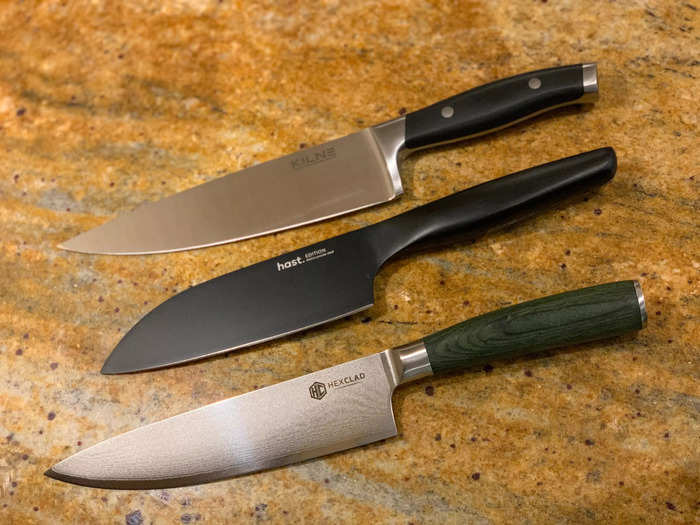
Depending on your budget, you may want to consider other options besides a knife set. Any time you're buying a set of something, the brand and/or manufacturer often adds in fillers (i.e. less than useful pieces) and cuts corners, and the case is no different with knives.
A lot of chefs we spoke with recommend keeping only one, two, or maybe three knives in a kitchen: a chef's knife for most tasks, a paring knife for smaller jobs like peeling fruit or scoring dough, and a bread knife. You might also consider forgoing a knife block for a magnetic bar, which takes up far less space when stuck to the side of your fridge or mounted on a wall. Over time, you may want to add something like a utility or boning knife, but the truth is most kitchens will rarely find much use for one. If you do need one, you know who you are, and you probably carve a lot of poultry and/or meat.
Read our guide to the best individual kitchen knives.
Knife set FAQs
How many knives do I really need?
You can get away with as few as one, but three or four will easily enable you to do everything: a chef's knife, a paring knife, a bread knife, and maybe a utility or carving knife will get you through any and every task.
What is an HRC rating?
Hardness Risk Rating (HRC), or the Rockwell Scale, is a measurement of the hardness of steel based on how deep a diamond-tipped indenter penetrates it.
Note that it's not only the steel or the metallurgic compound itself so much as how it's hardened (tempered). A low hardness rating for a blade is anywhere in the 50s, while harder steel is usually upwards of 60.
The harder the steel, the longer the edge holds, but that also usually makes the knife more brittle, more likely to chip, and more difficult it is to sharpen when the time comes. The softer the steel, the easier it is to sharpen, but you'll have to do so often.
Popular Right Now
Advertisement